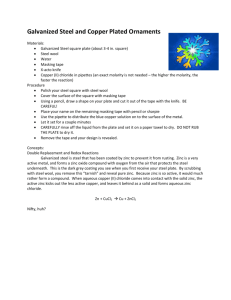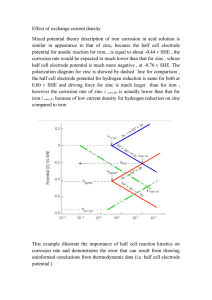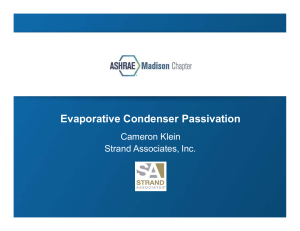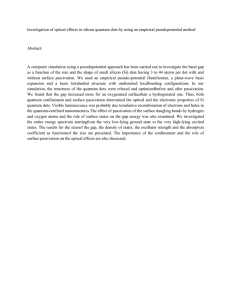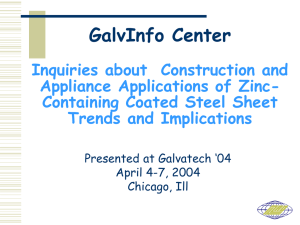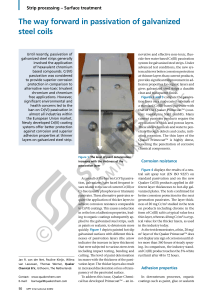White Rust on Galvanized Steel
advertisement
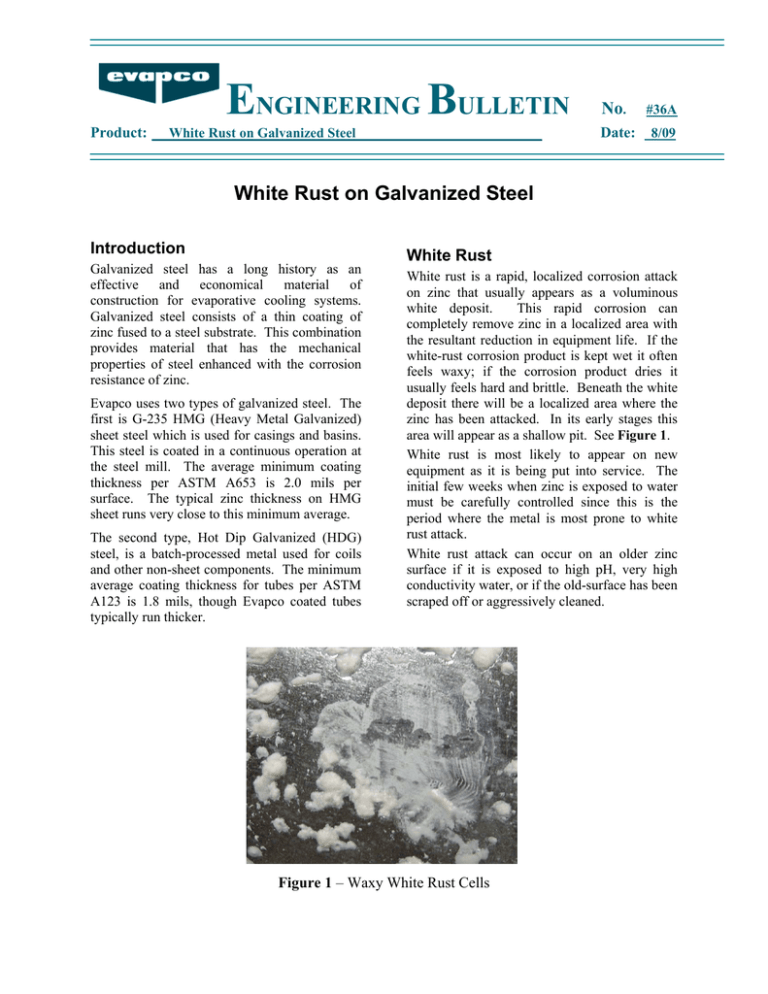
ENGINEERING BULLETIN Product: White Rust on Galvanized Steel No. #36A Date: 8/09 White Rust on Galvanized Steel Introduction Galvanized steel has a long history as an effective and economical material of construction for evaporative cooling systems. Galvanized steel consists of a thin coating of zinc fused to a steel substrate. This combination provides material that has the mechanical properties of steel enhanced with the corrosion resistance of zinc. Evapco uses two types of galvanized steel. The first is G-235 HMG (Heavy Metal Galvanized) sheet steel which is used for casings and basins. This steel is coated in a continuous operation at the steel mill. The average minimum coating thickness per ASTM A653 is 2.0 mils per surface. The typical zinc thickness on HMG sheet runs very close to this minimum average. The second type, Hot Dip Galvanized (HDG) steel, is a batch-processed metal used for coils and other non-sheet components. The minimum average coating thickness for tubes per ASTM A123 is 1.8 mils, though Evapco coated tubes typically run thicker. White Rust White rust is a rapid, localized corrosion attack on zinc that usually appears as a voluminous white deposit. This rapid corrosion can completely remove zinc in a localized area with the resultant reduction in equipment life. If the white-rust corrosion product is kept wet it often feels waxy; if the corrosion product dries it usually feels hard and brittle. Beneath the white deposit there will be a localized area where the zinc has been attacked. In its early stages this area will appear as a shallow pit. See Figure 1. White rust is most likely to appear on new equipment as it is being put into service. The initial few weeks when zinc is exposed to water must be carefully controlled since this is the period where the metal is most prone to white rust attack. White rust attack can occur on an older zinc surface if it is exposed to high pH, very high conductivity water, or if the old-surface has been scraped off or aggressively cleaned. Figure 1 – Waxy White Rust Cells Zinc Passivation Like many metals, the good corrosion properties of zinc are due to a thin film of corrosion product that forms on the surface of the metal. This tightly-adherent corrosion film is called a passivation layer. The formation of the passivation layer is essential to achieving longlife with a galvanized product. Zinc will naturally form a passivation layer when exposed to weathering over an extended period of time. Rain combined with air drying will, over the course of a year or more form a passivation layer on all areas of the zinc which do not come in contact with recirculating water. Thus, the exterior of evaporative equipment and all interior areas above the drift eliminators will naturally develop a passivation film. For the components of the system that are exposed to or immersed in recirculating water, the water chemistry must be carefully controlled until a passivation film forms. Once the film forms, the recirculating water chemistry, though still important, is less critical for zinc corrosion. If the passivation film is damaged by abrasion or chemical attack, it must be re-formed by again carefully controlling the recirculating water chemistry. It is very difficult to control these water parameters and form a passivation layer in a system started under load due to the higher temperature and the continually changing water chemistry. Therefore, if possible, the equipment should be commissioned with water circulation and without a heat load. The critical parameters to form the passivation film are described in the following table. It generally takes 4 to 12 weeks to passivate zinc with pH control the most critical parameter and with the first few weeks of water exposure being the most critical time. Figure 2 Bright and Shiny Fresh Zinc Parameter Passivation Value pH 7.0 – 8.0 Conductivity <2,400 Calcium Hardness >50 ppm Chlorides <250 ppm Sulfates <250 ppm Alkalinity <300 ppm Chlorine (biocide) <0.5 ppm Fresh zinc has a bright shiny appearance; passivated zinc acquires a dull gray metallic appearance. See Figure 2 and Figure 3. Before the cooling equipment is delivered to the site, Evapco recommends that a written passivation plan be developed. This plan should be based on the site-specific make-up water and include how the appropriate water chemistry will be maintained, how the system will be run, and who will be responsible for conducting the passivation. Summary Galvanized steel is an excellent material of construction for evaporative cooling systems, which, with proper care, will have a long service life. Before any water is added to a new piece of galvanized equipment, the equipment operator should have a detailed plan for passivation of the galvanized metal and continued water treatment after passivation. See your local water treatment specialist for more information. Figure 3 Dull Gray Passivated Zinc
